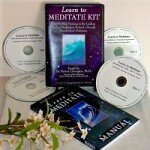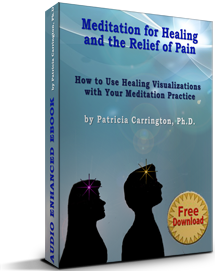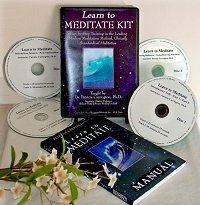What is Meditation?
Meditation has often been called the "ageless practice." It has its origins early in the history of the human race, probably being used by countless humans long before there was in a written language that could describe it.
The experience that underlies it — the meditative mood — is familiar to all of us, although the formal practice of meditation is one that needs to be learned through instruction or imitation.
To best describe the meditative mood, picture a mother holding her infant close to her and uniting with the child in a gentle rhythm as she rocks and sings to it. This mother is in another time and place in a sense as she bonds with her baby . She experiences that fragile all enveloping mood which I (P. Carrington) have called the "meditative mood."
Or, imagine a traveler leaning against a tree as he listens to the sounds of the breeze rustling the treetops. The traveler is so carried away by this experience and becomes so much part of it that he barely senses his own breath: it is as though he had "become" the wind as he experiences a meditative mood.
Or think of a camper who is gazing into a lowering fire, following the trail of the glowing ashes as they drift upward and fade into darkness; she feels as though she, too, were floating gently through space. This woman is enveloped by the meditative mood.
I could go on and describe many instances of this mood in our everyday lives but I think you already know
what I am referring to. Perhaps meditation as a discipline is no more than this spontaneous process that we all have experienced at times, simply developed into a formal practice.
Despite the fact that the meditative mood occurs naturally, people throughout the ages have nevertheless developed hundreds, perhaps thousands, of ingenious methods for intentionally evoking it. These methods have been carefully cultivated and handed down over the generations.
What are some of meditation systems that humans have worked out to hold onto this fragile mood?
The Meditative Techniques
There are literally hundreds of practices which can be listed under the heading of "meditation". All of these have in common the ability to bring about a special kind of free-floating attention where rational thought is bypassed and words are of far less importance than they are in everyday life. It is characteristic of this state that when we are in it we are completely absorbed in our attention to our particular object of meditation. If something else comes to mind, it usually drifts in with a sort of vague, faraway quality, then drifts out again.
The practices used to bring about this deeply quiet state are as diverse as gazing into a candle flame in one form of meditation; attending to the mental repetition of a sound (mantra) in another; giving close attention to a one's own breathing in still another; concentrating on the imagined sound of rain fall; chanting out loud a ritual word or phrase; attending to one’s bodily sensations with rapt attention; concentrating on an unanswerable riddle (a koan); passively witnessing the flow of thoughts as they pass through the mind; or whirling in a stereotyped dance as do the Sufis.
Whatever the form it takes the aim of meditation is the same: to alter the way the meditator experiences his or her own existence.
Shutting Out The World Temporarily
It's worth noting that all the meditative techniques close out the distractions of the outer world in much the same way as an isolation chamber does. In a sensory- deprivation experiment the subject is removed from incoming sense impressions by being placed in a sound proof room, by wearing goggles to eliminate patterned vision, or by undergoing other sense reducing manipulations. In a similar manner, in meditation the meditator removes his attention from any distracting sense impressions and thoughts by creating an "inner isolation chamber" of his own making. It is when the outer world is removed in this manner that meditation can take effect and the individual is said to become "centered".
Basically, we can discern two distinct types of meditation. Some types of meditation are not permissive, or may even be coercive with respect to the handling of "distractions of the mind" during meditation. A non-permissive form of meditation will demand strict concentration on the object of meditation. Practitioners will be directed to pinpoint their attention, to banish intruding thoughts from their mind by an act of will, and to return immediately and forcefully to the object of focus whenever they find their attention has wandered. This approach can be seen in extreme form in instructions given to a meditator in a fifth century Buddhist treatise dealing with thoughts that may intrude into the the meditation:
“… With teeth clenched and tongue pressed against the gums, he should by means of sheer mental effort hold back, crushed and burned out the offending thought …(so that) he will become inwardly calm, composed and concentrated."
In contrast, some modern meditative systems use varying degrees of permissiveness toward intruding thoughts. In these more permissive techniques, the meditator is instructed to return gently and without effort to the object he or she is focusing upon.
These modern techniques for meditation ask the meditator to make no conscious effort, but "let things happen" rather than make them happen. Such a permissive approach, because it encourages an accepting attitude toward thoughts or feelings which may inadvertently arise during meditation, may help the meditator to handle previously unacceptable feelings which she might have been hiding even from herself. It often leads to a more balanced, peaceful and confident attitude in life. It may also help release emotional tensions in a powerful way.
The Modern Forms of Meditation
You may have heard of Transcendental Meditation (TM), a standardized form of “mantra” meditation (meditation where the meditator concentrates upon a special powerful sound known as a mantra). This method was adapted for Western use from ancient Indian techniques. A large body of experimental evidence supports the value of TM and a few other forms of modern meditation in an impressive manner.
Another standardized form of modern meditation widely used in clinical practice to support psychotherapy or to create profound personality change on one's own is my Clinically Standardized Meditation (CSM) method. CSM does not involve any special ceremony but merely the use of a quiet room, some plants pleasantly arranged and repetition of a short standardized soothing sound, a "mantra," which the meditator has personally selected. It is remarkably effective in bringing about profound positive changes in the person using it. It is also very safe and simple to use and its beneficial effects have been widely supported by research.
In whatever form it is learned, meditation is, in a sense, a rebirth of a part of ourselves all too often neglected in modern life. Taking up this practice, if it properly learned and regularly practiced, can represent a new beginning, a significant commitment to one's own growth. Since CSM instruction emphasizes the effortlessness of the meditation technique and its permissive nature, CSM lies, as does TM, at the permissive end of the scale relative to many other meditation techniques which can require considerable concentration. The main advantages of CSM for example lie in its simplicity, its flexibility and its sensitivity to the individual needs of the people who learn it.
Combining Meditation with Other Forms of Treatment
One of the most impressive features of modern meditation is its use as an adjunct to psychotherapy. In my work as a clinical psychologist, I have been using my CSM form of meditation in this manner for over 25 years with clients and groups, and have obtained outstanding results from this combination.
I have written a book devoted largely to the manner in which a simple form of meditation can contribute to the emotional health of those using it and in in this book I present a host of examples taken from clinical practice where this has been the case – some truly fascinating stories are in there. This book is not only a popular compendium of unusual meditation information but is also being used as an instructional text by many psychotherapists throughout the world who seek to increase the effectiveness of psychotherapy so that they can help people on an even more profound level (see The Book of Meditation — formally entitled Freedom in Meditation).
Another combination of techniques that has yielded dramatic effects for those who use it is a strategic blend of modern meditation and the powerful self-help method known as EFT/tapping (see What Is EFT?). I have written in another section of this site about the major contribution that meditation can make to EFT practice but it also works the other way around . EFT can target specific problems in a person’s life at the same time that meditation handles that person’s global response to life in general.
Meditation actually changes the tenor of one's life as EFT zeroes in on specific issues that need to be changed in order that the person have a happier and more fulfilling life, and to overcome specific symptoms.
Also, by using the Choices Method the meditator can instill positive goals and directions in his or her life while leaving the meditative mood untouched for those times when being perfectly still and quiet of mind is ideally restorative. Being able to change one's life using both these approaches – the specific along with the global – is extremely effective.
If if you are a meditator or would be meditator, you may well want to look into the EFT tapping method and see how it might be used to supplement your meditation practice (see my article 10 Ways to Combined Meditation with EFT).
For a complete understanding of the modern meditation methods and how they can be used to treat emotional problems or enrich one's life see The Book of Meditation and The Learn to Meditate Kit.
For a complete understanding of the modern meditation methods and how they can be used to treat emotional problems and actually change one's life for the better, see my book "The Book Of Meditation."
By Dr.




